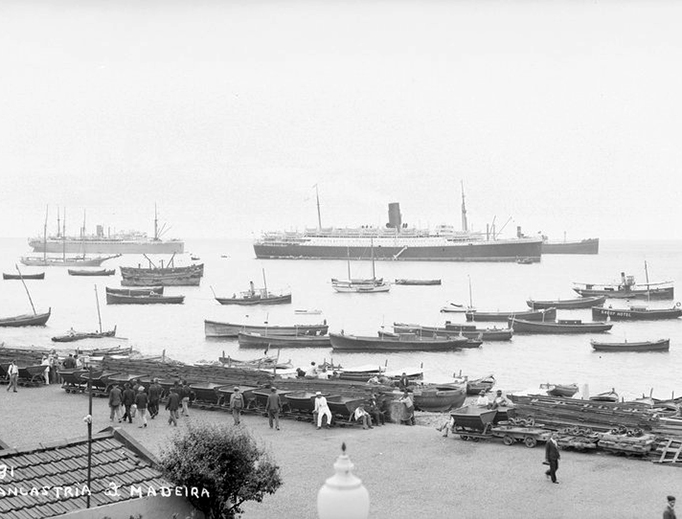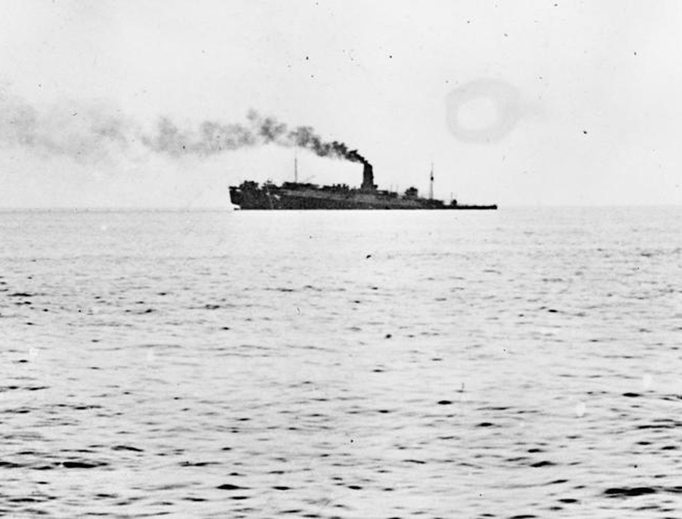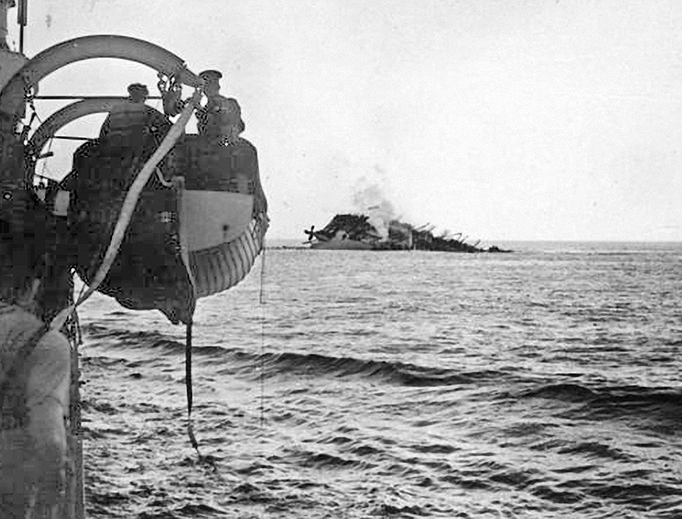These WWII Stories of Heroism Will Make You See Dunkirk in a Whole New Light
While the Lancastria disaster was hushed up for many years after World War II, the courage of these two chaplains could not be contained.

The story of Dunkirk — with all of its heroism and what many called the “Miracle of Dunkirk” — bolstered the hopes and morale of the British, as defeat seemed behind the door closing on them in France in World War II’s early days. The movie Dunkirk is a tribute to the fortitude of the local people to snatch from the surrounding enemy and bring to the safety of Britain as many soldiers as they could in a few days.
The eve before the operations began, on May 26, King George VI declared a national day of prayer. Miraculously, between then and June 4, the British saved 338,226 stranded in France — nearly 200,000 British Expeditionary Forces (BEF) and 140,000 Allied French, Polish and Belgian military.
Yet 13 days later, this triumph was followed by a horrible tragedy.
History records the triumph of this code-named “Operation Dynamo,” as does the movie Dunkirk, which waits to do so until after the relentless barrage of harrowing moments and terrible losses — one after the other — before help arrives. But something the movie cannot bring to light is the evacuation event that followed two weeks later during a second evacuation of military personnel and civilians.
This next round of evacuations took place June 15-25 near St. Nazaire.
There, on June 17, 1940, Britain was to suffer its greatest maritime disaster of all time. It, too, became a time of heroism and sacrifice, highlighted by two Catholic military chaplains.
But in the euphoria of the moment, the debacle of June 17 was hushed up on orders from the government so that the people’s high morale boosted by Dunkirk would not burst by hearing what happened to the Lancastria.
During what was called “Operation Ariel,” this ship lost more than the Titanic and Lusitania combined. The Titanic lost 1,517 souls; the Lusitania lost 1,198 when sunk in 1915 by a German U-boat.
The Ship
The Lancastria had been a British Cunard luxury liner from the day it was launched in 1922. Even the Catholic Boy Scouts of Ireland had chartered Lancastria for a pilgrimage to Rome. But that June 17 the military and civilians boarding the ship were going on no pleasure cruise.
When World War II commenced, in April 1940, the Lancastria was converted into a troopship. Less than two months later, she was ordered to join Operation Ariel for the continuing evacuation of troops, British nationals and Royal Air Force (RAF) personnel still needing to leave France. The Lancastria headed to St. Nazaire, more than 420 miles to the southwest of Dunkirk, to pick up the evacuees. She arrived on June 16.
The Lancastria’s limit was 2,200 passengers, plus a crew of more than 350, but the Royal Navy gave the captain orders to cram as many as possible onto the ship, “without regard to the limits laid down by international law.”
One official source noted that a soldier heard the captain and his chief officer say that 6,700 people were aboard the ship already, and the small vessel bringing more evacuees would be the last he could allow. Other estimates go as high as possibly 9,000 people aboard.
Suddenly, German bombers appeared. They were unchallenged because, at the time, Royal Air Force fighters were at the other end of their patrol perimeter. An hour earlier, the bombers had hit a ship half a mile from the Lancastria. As the largest ship at the evacuation and anchored a few miles offshore, the Lancastria became a prime target.
The Disaster
At 3:48pm, the Lancastria suffered three direct hits by bombers. One bomb exploded down the second hold, where 800 RAF personnel were jam-packed. A fourth bomb went down the smokestack into the ship’s innards, killing hundreds and causing 1,400 tons of crude oil to be released into the water around the ship.
In only 20 minutes, after suffering such massive damage, the Lancastria keeled over and sank bow first.
Those able to escape had to deal with the great distance from shore, the heavy oil slicks, and the German planes that came back again and again to strafe survivors and to set the leaked oil ablaze, too, killing as many as they could.
Smaller vessels in the area that had been ferrying the evacuees from shore to the larger ships like the Lancastria tried to rescue as many as possible. In all, 2,477 survived the disaster, the youngest being a 2-year-old girl with her parents, who also lived.
Because there wasn’t an exact number count of those aboard the Lancastria, it was impossible to get the precise figure of how many souls were lost. Some sources say up to 5,800, or even 6,500, died, taking into account the possible 9,000 on board. Subtracting the 2,477 known survivors from that report overhearing the captain say 6,700 were aboard and he was accepting only one more boatload, puts the figure at over 4,200 souls lost.
A sea-front memorial was erected nearly 50 years later at the shore in “memory of more than 4,000 who died and in commemoration of the people of St. Nazaire and surrounding districts who saved many lives, tended wounded and gave a Christian burial to victims.”
Chaplain’s Greater Love
Four Catholic chaplains were aboard the ship.
Actor David Niven told the story of one to William Buckley, who included it in his book Nearer, My God: An Autobiography of Faith. Fighting in the British forces during World War II, Niven learned of this major heroic action from several soldiers who were firsthand witnesses.
Niven recounted that after the fourth bomb that went down the Lancastria’s funnel exploded, “In the hold there were several hundred soldiers. Now there was no way they could ever get out because of the list, and she was sinking. And along came my own favorite Good Samaritan, a Roman Catholic priest, a young man in Royal Air Force uniform. He got a rope and lowered himself into the hold to give encouragement and help to those hundreds of men in their last fateful hour … knowing he could never get out, nor could they. The ship sank, and all in that hold died.”
“The remainder were picked up by the destroyers and came back to England to the regiment I was in, and we had to look after them; and many of them told me that they were giving up even then, in the oil and struggle, and the one thing that kept them going was the sound of the soldiers in the hold singing hymns.”
How comforting to those men it must have been to have with them a chaplain, who also undoubtedly gave them absolution at that moment and strengthened them with his own remarkable selfless act to be with them. He certainly would be among the chaplains who both then and later came along doing the same, such as Servants of God chaplains Emil Kapaun of the Army and Vincent Capodanno of the Marines, who also refused to leave their men.
While we know the story of the last two, this RAF chaplain remains in obscurity. One reason is that the whole story of the Lancastria was suppressed per orders of Winston Churchill and the government. Phone calls this July to the headquarters of the British military chaplaincy learned that neither the office nor the retired archivist for this office, a specialist in World War I and II, had any idea who this chaplain was. Only the men he inspired and the Good Lord know.
Another Heroic Chaplain
But we do know the name of another heroic chaplain aboard the Lancastria — Father Charles McMenemy. Numerous accounts of his actions during the attack made papers about five weeks later, despite the government’s suppression, and some incidents were recounted in the book called Lancastria, as recorded in the “Lancastria Archive.”
An Army chaplain with the BEF in France, 35-year-old Captain Father McMenemy was about to get a rest lying on the floor on a “Li-Lo” he had been carrying (a brand name for a plastic or rubber air mattress normally used to lie on or to float on water).
When the first bombs hit, he thought it was the ship’s own heavy guns being fired, but when he smelled the explosives and felt the ships roll, he knew what happened. He made his way to the corridor packed with about 300 troops. An officer was ordering the men up a companionway to the deck.
Father McMenemy saw two men without lifebelts. There were only the required 2,200 lifebelts aboard for a normal number of passengers.
“Can you chaps swim?” he asked. They shook their heads no.
“Take this then,’” he said, handing them the Li-Lo. “Get into the sea and climb on it. You’ll be all right.”
They thanked him and asked, “But what about you?”
“Don’t worry about me,” he answered. “I’ll be safe enough. If God wills, many others will be, too.” He gave them a blessing and continued along.
Another story published on Aug. 15, 1940, in a paper called The Scotsman repeated what a Miss J. Harding of Bromley, Kent, told them about her brother, an RAF sergeant who was at the bottom of the ship when it was hit. He told her “the companionways were crammed with troops, and it seemed as though the men down below were doomed.”
She said, “A sergeant major, my brother and several others standing together were approached by an Army chaplain, who quietly told them to put their faith in God and follow him. He led them through the bottom of the ship to some kind of exit in the side, about 6 feet above the water. Then he made them remove their heavy clothing before they jumped.” The sergeant major couldn’t swim, “so the chaplain took off his own lifebelt and handed it to him with the words that he would not need it, for if God willed he could come through alive.”
These men were among the rescued. They might have joined others because the book described, “Four soldiers, each holding one corner of a pale-blue Li-Lo, were paddling away nearby. On the inflated rubber cushion lay a wounded sergeant major.”
Another account tells of this courageous chaplain leading men to “some kind of exit at the side about six feet above the water,” and he had them remove their heavy clothing before they jumped into the sea.
Then up on deck, Father McMenemy began helping the crew try to free one of the rafts, which was still secured, but its mooring couldn’t be unfastened. The ship was listing so badly at this point that two sailors with them simply stepped into the sea and started swimming.
Once nothing more could be done, Father McMenemy began to swim out to see if others in the water needed help. Described later by another priest as a “fine athlete, a rugger [rugby] player and swimmer,” the chaplain spent about 45 minutes in the water before a boat picked him up.
It was a French tugboat. Once aboard, Father McMenemy went to work “helping to pull people from the sea as the boat cruised slowly backwards and forwards, finally dropping off the survivors alongside the destroyer Highlander. … The tug must have picked up five or six hundred, but it was grisly work, with less than an even chance of survival for so many.”
Surely Father McMenemy was not just pulling them aboard, but at the same time assuredly offering them comfort and hope. His calm manner already brought that comfort and hope to those he saved on the ship.
The chaplain survived, remained in army chaplaincy, and was assigned to an anti-aircraft unit. Before the war, he was also a prison chaplain, but after it ended, he became pastor of a small parish. He died in 1976.
Surely a number of those who were eventually rescued credited Captain Father McMenemy for their survival.
While the Lancastria became a major disaster and terrible tragedy hushed up for many years after, the courage of these two chaplains — and possibly the same for the other two chaplains who we’ll never know about — could not be contained.















